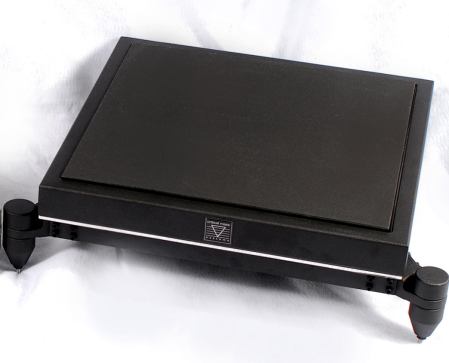You are reading the older HTML site
Positive Feedback ISSUE
40november/december 2008

Parting is Such Sweet Sorrow …
The Good Doctor Opines on Comings and Goings: Follow-up to the Critical Mass Black Platinum PXK System
Introduction
One of the constants of audio reviewing (like life, I suppose) is that things come and go, and like the people who move in and out of our lives …some give us pleasure by coming, and others by going. I must say that, on balance, I probably experience more of the latter than the former, both in life and audio. But there are times when saying goodbye is truly onerous.
Of late, two particular audio things come to mind; the BAT VK-52-SE line stage, which I loved …and the Critical Mass PXK system …which I also loved. I miss them both.
I have had Joe Lavrencik's Critical Mass Black Label stands and isolation platforms in my reference system for some time. As I observed in my earlier review of the PXK system, I had reached satori… with the Black Label system, and assumed this part of my audio hegira was finished. That was, of course, until the PXK. Alas, I simply could not swing the price of moving from the Black Label to the PXK, or be assured I would have done so in a heartbeat.

But this begs the question …do the significant advances of the PXK make the Black Label pale in comparison?
Before answering this most pregnant of questions, there are some things to consider. First and foremost is the ever present law of diminishing returns. It is a simple fact that in any process, activity, product or endeavor …the first half is a walk, the next 25% is a struggle, and from then on, each incremental change generally represents an exponential increase in time, effort, sweat, resources and, of course, cost. Ad nauseam …how many times has the obvious been stated that a piece that costs ten times as much is probably not going to be ten times better (there are of course exceptions to everything, including this)?
First, "better" in audio has become such an elusive and highly variable concept as to be typically more contentious than useful. Yes, for those things for which we have reasonable measures… "better" can be established, at least at the pieces and parts level …but the ultimate result in a complex audio system is inextricable from the perception thereof and here it all gets murky as we all obfuscate by replacing principles with preferences …at least to some degree.
I think often we hear differences and ascribe value to those differences consistent with our own unavoidably idiosyncratic preferences.
But I am feeling puckish and up to the challenge of "better" today, for some reason; perhaps because I am freshly returned from an invigorating and enormously entertaining vacation with a particularly unique and valued friend, who journeyed for her first time to Oregon from her native land of Virginia.
So, to "better…"
The most immediately obvious difference between the Black Label and PXK systems is the construction. The former uses sturdy but unremarkable maple stands; the later high tech machined and finished aircraft aluminum. The Black Label goes together as one might expect …the stands come assembled and one simply places the filter platforms on their respective tiers …job done. The PXK goes together like assembling a fine weapon, with precision screw-together pieces and even these cool little ball bearings, upon which the elegantly slim filter platforms rest.
One can easily see where a great deal of the extra money goes for the PXK …advanced engineering, new and exotic materials, precision machining …and of course, looking way cool. And trust me, they look WAY cool.
The PXK filter platforms are different …much thinner, which adds to the overall appearance of a more "engineered" product. The PXK is also a tripod, rather than a conventional four-poster. The silky brushed silver and champagne of the Marantz Reference system on the PXK stands was a joy to be behold each and every time I looked; truly scrumptious combination in every way imaginable.

So the first answer to the question of what accounts for the difference in price is quite objectively apparent.
But …all of these refinements come at a cost, and more refined engineering and materials are expressly intended to push the envelope for that slippery last few percentage points of performance. Remember, the difference between a 6.48 and a 4.34 ET, or between a 5:46 and 4:12 mile are incremental in absolute terms, but universes different in required investment.
Through the Past Darkly
So one day Joe showed up to break down and recover the PXK and replace it with my Black Label stands. Nothing quite like having the designer do the optimization and I learned a great deal by watching the meticulous care he lavished on making sure I got the best out of my Black Label system. I mean, this is a guy who made sure the front faces of both components and the stands themselves were perfectly aligned. Whew.
Then we fired the Marantz Ref system back up.

I suppose probably less than an hour spanned taking down the PXK and getting the Black Label back in place. Nope, not an AB for sure, but heck …close enough for subjective audio journalism.
So, what was the level of change? Precisely what you might reasonably anticipate …the difference between a 6:48 and a 4:34 ET.
I've done a 6:48 …and I am here to tell you that are fast …and makes for a helluva ride. It takes a lot of money, time and effort to get to 6:48 and it is absolutely worth if, if this is the experience you seek. Frankly, this level of optimization for most systems is so huge (the Black Label) it easily matches or exceeds the sum total of the system components. By this, I mean …it will allow you the best of out of 90% of the systems out there. This makes the Black Label the high-value choice for most people. The results are superb.
But in all candor, I have to admit knowing I had moved back from the incomparable performance of the PXK. If you crave Bugatti's, Chateau L'Tour, tartufo bianco, Renoirs and never seeing anyone's taillights except as you sweep past them …there is the PXK.
Ok, Enough with the Metaphors …How do they Sound Differently?
Bigger, deeper, wider, longer …more air, more separation …more. The experience is very much like when I upgraded from Symphony level Jena Labs cabling, to Dream Dancers. Both systems perform precisely as they are intended, both are excellent. Initially it is most obvious at the frequency extremes, both bass and treble extension and weight.
But moving back made me immediately aware of perhaps the most significant difference.
It is not uncommon for average folks hearing my system to ask where the rear speakers are. Of course, there are none …but this pretty neatly defines what may be the most salient point here. In my system, with the PXK there is the definite illusion of surround.
I don't know why …perhaps some fortuitous combination of the dispersion characteristics of the un-lens-ed VMPS-20's and the aggregate of the rest of the system (including my room)… but this illusion collapses when we go back to the Black Label. The system still produces very nicely layered, front to back soundstage, but that ineffable feeling of being more or less surrounded goes away. I have to say, I miss that very much.
If you are in search of that ineffable and elusive "there" and you have the resources, the refinement and a quality-commensurate system and room …the PXK is your girl. I seriously doubt you could do better at any price.
The combination of the Marantz Reference System, Jena Labs cabling and AC treatment and the PXK stands remains overall the finest result I have personally heard from a two-channel home audio system. The resultant musicality made me more or less indifferent to sources, formats and other considerations. Everything sounded like music …and the freedom this level of performance provides is a truly profound experience if you are a music lover first and an audiophile secondly. I could simply move back and forth through sources, formats, genres …whatever, without being unconsciously steered to, or away from things. I listened to whatever I wished, and enjoyed it all.
With the ability to tweak the external VMPS crossovers and the HSU mid-bass/sub system I always had the ability to render even thin, somewhat strident recordings in a musical fashion. For example, one of my favorite versions of the old Holst chestnut, The Planets is the Bernstein recording; instead of plodding ponderously through the pieces as so often is the case, his reading is all speed, fire and splash …but the recording itself can be a bit shrill and dry. Just by touching up the bottom a bit and dialing the tweeters down a smidge on the VMPS's, I got the best of the performance without having to wince through the recording.
This is my idea of how an audio system should operate. Screw that hair-shirted "take it as it comes" crap. I will sample the dish as it comes from the restaurant kitchen, but after that, since I am paying for it, I will do whatever the hell I want with it.
But back from my digression …are the differences between the two systems sufficient to justify the price difference? Absolutely; but make no mistake …at the PXK level you have to be on your "A" game …no less than equal partners …no gatekeepers, no weak-ass compromises.
And another big "but; taken free-standing, aside from the comparison of the much pricier PXK, the Black Label system is a remarkable performer and a superb value. Although I miss the PXK, I am perfectly delighted with my Black Label system. For the vast majority of audiophiles the Black Label system will never be the unknown compromise in their system.
But …if you, like Joe Lavrencik are compelled to chase the dragon …to feel what the real difference is between superb and transcendent …you will count the PXK as well worth the cost and never look back.
Putting Critical Mass on notice here, the PXK system will be one of my Writer Awards picks for 2008, no questions.
Specific details of both systems are addressed in previous reviews.
System Retail Pricing:
3 tier PXK - $3300 per level, or $9900. The system is modular so the user can select the vertical spacing.
3 tier Grand Master rack is $2400 X 3 + $1500 for the rack, or $8700. The rack and GMs are custom sized.
3 tier Master rack is $2000 X 3 + $1500 for the rack, or $7500. All can be custom made.
3 tier Reference rack is $1,800 X 3 + $1500 for the rack, or $6,900. All can be custom made.
Critical Mass
69 Windsor Dr.
Oak Brook, IL 60523
(630) 640-3814
email address:
[email protected]
Locus Design www.locus-design.com/index.html
